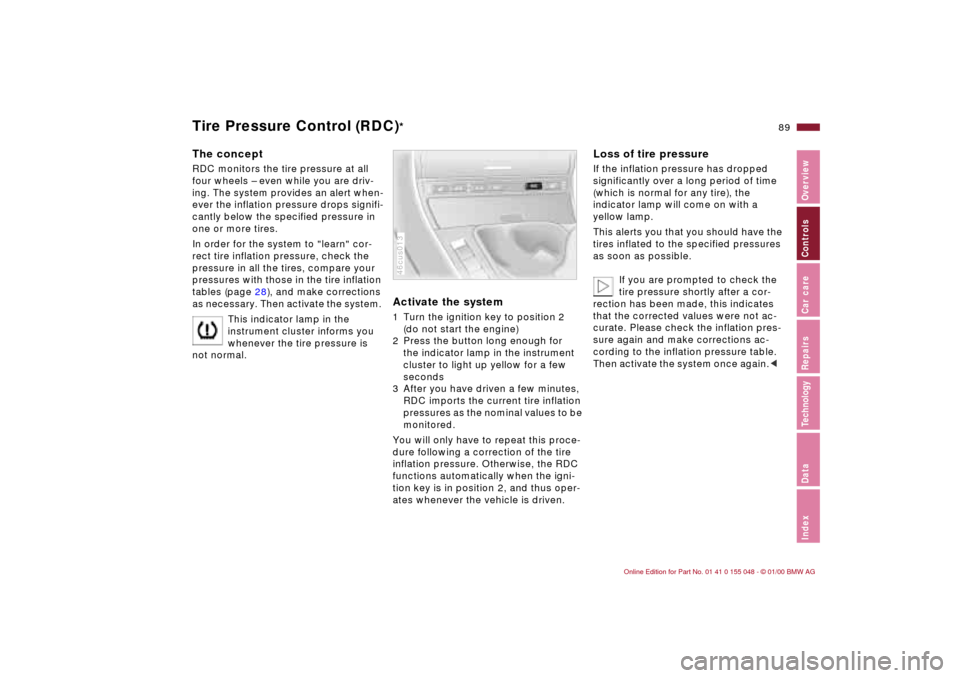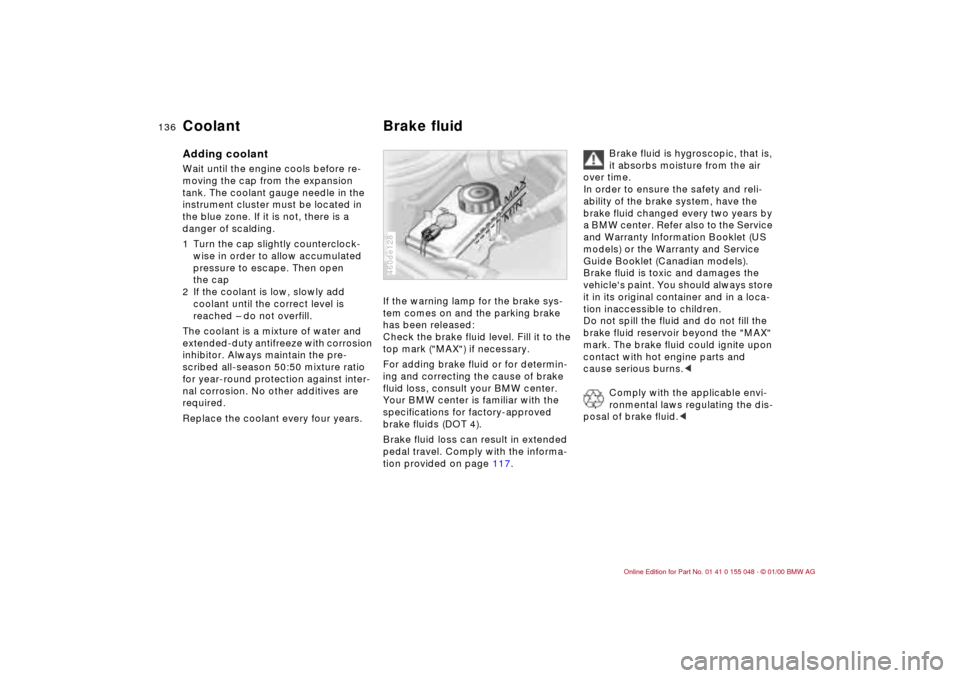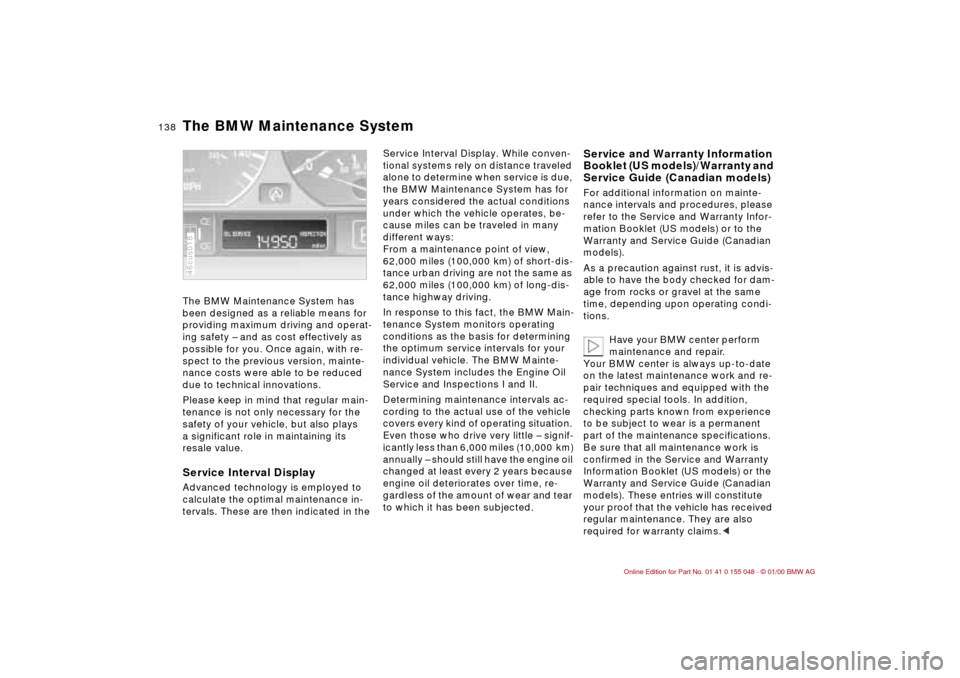2000 BMW 328Ci CONVERTIBLE check engine
[x] Cancel search: check enginePage 83 of 199

83n
IndexDataTechnologyRepairsCar careControlsOverview
Fuel gauge
Coolant temperature gauge
Service Interval Display
When you switch on the ignition, the
indicator lamp lights up briefly as an
operation check.
Once the indicator lamp stays on con-
tinuously, there are still approx. 2.1 gal-
lons (8 liters) of fuel left in the fuel tank.
For fuel tank capacity, refer to page 185.
If the tilt of the vehicle varies (extended
driving in mountainous areas, for exam-
ple), there may be slight fluctuations of
the needle.
Please refuel early, since driving
to the last drop of fuel can result in
damage to the engine and/or catalytic
converter.<462us020
BlueThe engine is still cold. Drive at moder-
ate engine and vehicle speeds.RedWhen you switch on the ignition, the
warning lamp comes on briefly to con-
firm that the system is operational.
If the lamp comes on while operating
the vehicle the engine is overheated.
Shut off the engine immediately and
allow it to cool down.Between the blue and red zonesNormal operating range. It is not un-
usual for the needle to go as far as the
edge of the red zone in response to
high outside temperatures or severe
operating conditions.Checking coolant level, refer to page 13 5.460de082
Remaining distance for serviceThe displays shown in the illustration
appear for a few seconds when the
ignition key is in position 1 or after the
engine is started.
The next service due appears with the
message OILSERVICE or INSPECTION,
together with the remaining distance
before scheduled service.
The computer bases its calculations of
the remaining distance on the rate of
fuel consumption in the period immedi-
ately preceding your data request.
A flashing display and a "–" in front of
the number indicate that service inter-
val has already been exceeded by the
distance shown in the display. Please
contact your BMW center for an
appointment.46cus006
Page 89 of 199

89n
IndexDataTechnologyRepairsCar careControlsOverview
Tire Pressure Control (RDC)
*
The conceptRDC monitors the tire pressure at all
four wheels – even while you are driv-
ing. The system provides an alert when-
ever the inflation pressure drops signifi-
cantly below the specified pressure in
one or more tires.
In order for the system to "learn" cor-
rect tire inflation pressure, check the
pressure in all the tires, compare your
pressures with those in the tire inflation
tables (page 28), and make corrections
as necessary. Then activate the system.
This indicator lamp in the
instrument cluster informs you
whenever the tire pressure is
not normal.
Activate the system 1 Turn the ignition key to position 2
(do not start the engine)
2 Press the button long enough for
the indicator lamp in the instrument
cluster to light up yellow for a few
seconds
3 After you have driven a few minutes,
RDC imports the current tire inflation
pressures as the nominal values to be
monitored.
You will only have to repeat this proce-
dure following a correction of the tire
inflation pressure. Otherwise, the RDC
functions automatically when the igni-
tion key is in position 2, and thus oper-
ates whenever the vehicle is driven.46cus013
Loss of tire pressureIf the inflation pressure has dropped
significantly over a long period of time
(which is normal for any tire), the
indicator lamp will come on with a
yellow lamp.
This alerts you that you should have the
tires inflated to the specified pressures
as soon as possible.
If you are prompted to check the
tire pressure shortly after a cor-
rection has been made, this indicates
that the corrected values were not ac-
curate. Please check the inflation pres-
sure again and make corrections ac-
cording to the inflation pressure table.
Then activate the system once again.<
Page 115 of 199

115n
IndexDataTechnologyRepairsCar careControlsOverview
Antilock Brake System (ABS)Antilock Brake System (ABS)/
Cornering Brake Control (CBC) CBC is an advanced engineering de-
sign of the ABS. When braking while
cornering at high speed or braking dur-
ing high lateral acceleration, or when
braking during a lane change, vehicle
stability is improved and steering re-
sponse is enhanced.
In the event of a malfunction
If the ABS warning lamp in the
instrument cluster lights up,
refer to page 22. The brake
system then reverts to conventional
operation as on vehicles without ABS.
However, have the brake system
checked by your BMW center as soon
as possible, to prevent undetected
defects and cumulative faults from
adversely affecting the brake system.
ABS warning lamp for Canadian
models.
If the brake warning lamp
comes on together with the indi-
cator lamps for ABS and DSC –
refer to page 21 – the entire
ABS, CBC and DSC control sys-
tem has failed. Continue driving
cautiously and defensively.
Avoid full brake applications.
This could cause the vehicle to lose
stability and you might no longer be
able to control it.
Have the system checked as soon as
possible by your BMW center.
Indicator and warning lamps
CBC, ABS and DSC for Cana-
dian models.
Page 133 of 199

133n
IndexDataTechnologyRepairsCar careControlsOverview
Engine oilChecking the oil level 1 Park the vehicle on a level surface
2 Shut the engine off after it has
reached normal operating tempera-
ture
3 After approx. 5 minutes, pull the dip-
stick out and wipe it off with a clean
lint-free cloth, paper towel, or similar
material
4 Carefully push the dipstick all the way
into the guide tube and pull it out
again
5 The oil level should be between the
two marks on the dipstick.
As with fuel economy, oil consumption
is directly influenced by your driving
style and vehicle operating conditions.462de244
When the oil is between the two
marks on the dipstick, there is approx.
1.1 US quarts (1 liter). Do not fill be-
yond the upper mark on the dipstick.
Excess oil will damage the engine.460de189
To add oil Wait until the level has dropped to just
above the lower mark before adding oil.
However, never let the oil drop below
the lower mark.
BMW engines are designed to op-
erate without oil additives; the use
of additives could lead to damage in
some cases. This also applies to the
manual transmission, the automatic
transmission
*, the differential, and
power steering system.<
462de245
Page 135 of 199

135n
IndexDataTechnologyRepairsCar careControlsOverview
Engine oil Coolant
Always comply with all environ-
mental protection guidelines and
regulations when disposing of used oil
.<
Recommendation: have the oil changed
by your BMW center only.
Continuous exposure to used oil
has caused cancer in laboratory
testing.
For this reason, thoroughly wash any
areas of skin that come into contact
with oil using soap and water.
Always store oils, grease and similar
materials so that they are inaccessible
to children. Comply with warning labels
and information on containers.<
Do not add coolant to the cooling
system when the engine is hot. If
you do, escaping coolant can cause
burns.
To avoid the possibility of damage later
on, never use anything other than fac-
tory approved nitrite and amino-free
extended-duty antifreeze with corrosion
inhibitor. Your BMW center is familiar
with the factory specifications.
Antifreeze and anticorrosion agents are
hazardous to health. You should always
store them in their original container
and in a location that is inaccessible to
children. Extended duty antifreeze with
corrosion inhibitor contains ethylene
glycol, a flammable substance. There-
fore, do not spill antifreeze with corro-
sion inhibitor on hot engine parts. It
could ignite and cause serious burns.<
Comply with the applicable envi-
ronmental laws regulating the dis-
posal of extended-duty antifreeze with
corrosion inhibitor.<
Checking coolant levelCorrect coolant level when the engine
is cold (approx. 68 7 or +20 6):
Unscrew the cap from the expansion
tank.
The coolant level is correct when the
upper end of the red float is at least
even with the upper edge of the filler
neck (refer to the arrow in the illustra-
tion), but no more than 0.8 inches
(2 cm) above it – that is, up to the
second mark on the float (refer also
to the schematic diagram next to the
filler neck).46cde036
Page 136 of 199

136n
Coolant Brake fluidAdding coolant Wait until the engine cools before re-
moving the cap from the expansion
tank. The coolant gauge needle in the
instrument cluster must be located in
the blue zone. If it is not, there is a
danger of scalding.
1 Turn the cap slightly counterclock-
wise in order to allow accumulated
pressure to escape. Then open
the cap
2 If the coolant is low, slowly add
coolant until the correct level is
reached – do not overfill.
The coolant is a mixture of water and
extended-duty antifreeze with corrosion
inhibitor. Always maintain the pre-
scribed all-season 50:50 mixture ratio
for year-round protection against inter-
nal corrosion. No other additives are
required.
Replace the coolant every four years.If the warning lamp for the brake sys-
tem comes on and the parking brake
has been released:
Check the brake fluid level. Fill it to the
top mark ("MAX") if necessary.
For adding brake fluid or for determin-
ing and correcting the cause of brake
fluid loss, consult your BMW center.
Your BMW center is familiar with the
specifications for factory-approved
brake fluids (DOT 4).
Brake fluid loss can result in extended
pedal travel. Comply with the informa-
tion provided on page 117.
460de128
Brake fluid is hygroscopic, that is,
it absorbs moisture from the air
over time.
In order to ensure the safety and reli-
ability of the brake system, have the
brake fluid changed every two years by
a BMW center. Refer also to the Service
and Warranty Information Booklet (US
models) or the Warranty and Service
Guide Booklet (Canadian models).
Brake fluid is toxic and damages the
vehicle's paint. You should always store
it in its original container and in a loca-
tion inaccessible to children.
Do not spill the fluid and do not fill the
brake fluid reservoir beyond the "MAX"
mark. The brake fluid could ignite upon
contact with hot engine parts and
cause serious burns.<
Comply with the applicable envi-
ronmental laws regulating the dis-
posal of brake fluid.<
Page 138 of 199

138n
The BMW Maintenance System has
been designed as a reliable means for
providing maximum driving and operat-
ing safety – and as cost effectively as
possible for you. Once again, with re-
spect to the previous version, mainte-
nance costs were able to be reduced
due to technical innovations.
Please keep in mind that regular main-
tenance is not only necessary for the
safety of your vehicle, but also plays
a significant role in maintaining its
resale value.
Service Interval DisplayAdvanced technology is employed to
calculate the optimal maintenance in-
tervals. These are then indicated in the 46cus018
Service Interval Display. While conven-
tional systems rely on distance traveled
alone to determine when service is due,
the BMW Maintenance System has for
years considered the actual conditions
under which the vehicle operates, be-
cause miles can be traveled in many
different ways:
From a maintenance point of view,
62,000 miles (100,000 km) of short-dis-
tance urban driving are not the same as
62,000 miles (100,000 km) of long-dis-
tance highway driving.
In response to this fact, the BMW Main-
tenance System monitors operating
conditions as the basis for determining
the optimum service intervals for your
individual vehicle. The BMW Mainte-
nance System includes the Engine Oil
Service and Inspections I and II.
Determining maintenance intervals ac-
cording to the actual use of the vehicle
covers every kind of operating situation.
Even those who drive very little – signif-
icantly less than 6,000 miles (10,000 km)
annually – should still have the engine oil
changed at least every 2 years because
engine oil deteriorates over time, re-
gardless of the amount of wear and tear
to which it has been subjected.
Service and Warranty Information
Booklet (US models)/Warranty and
Service Guide (Canadian models)For additional information on mainte-
nance intervals and procedures, please
refer to the Service and Warranty Infor-
mation Booklet (US models) or to the
Warranty and Service Guide (Canadian
models).
As a precaution against rust, it is advis-
able to have the body checked for dam-
age from rocks or gravel at the same
time, depending upon operating condi-
tions.
Have your BMW center perform
maintenance and repair.
Your BMW center is always up-to-date
on the latest maintenance work and re-
pair techniques and equipped with the
required special tools. In addition,
checking parts known from experience
to be subject to wear is a permanent
part of the maintenance specifications.
Be sure that all maintenance work is
confirmed in the Service and Warranty
Information Booklet (US models) or the
Warranty and Service Guide (Canadian
models). These entries will constitute
your proof that the vehicle has received
regular maintenance. They are also
required for warranty claims.<
The BMW Maintenance System
Page 147 of 199

147n
IndexDataTechnologyRepairsCar careControlsOverview
Vehicle storage
If you intend to store the vehicle
for more than three months, have
the maintenance operations described
on this page performed.<
Preparations for storageHave your BMW center perform the fol-
lowing procedures:
1 Clean and apply a rustproofing agent
or other treatment to the engine,
engine compartment, undercarriage,
axles and major components in ac-
cordance with approved repair pro-
cedures. Washing the vehicle, any in-
terior cleaning and subsequent paint-
and chrome care, and cleaning any
rubber seals for the hood and doors,
should be carried out in compliance
with approved procedures as well
2 Change engine oil and oil filter at op-
erating temperature. As an additional
corrosion protection measure, an an-
ticorrosive agent can be added to the
engine when refueling in accordance
with the manufacturer's instructions
3 Check the coolant level and concen-
tration and top off if necessary
4 Fill the fuel tank completely to pre-
vent the formation of condensation
5 Increase the tire inflation pressure to
51 psi (350 kPa).
Before parking the vehicle1 Dry the parking brake and footbrakes
completely to keep the brake discs
and drums from corroding
2 Park the vehicle in a covered, dry,
and well-ventilated space. Place the
transmission in first gear or set the
selector lever to the "P" position.
Chock the wheels to prevent the ve-
hicle from rolling if necessary. Do not
apply the parking brake
3 Remove the battery, charge it com-
pletely and store it in a cool (but
frost-free) room
4 Remove the hardtop
* and store it
separately. Refer to page 121
5 Close the convertible top.
During storageRecharge the battery every six months.
If it is not recharged, it will not be ser-
viceable. Every time the battery drains,
especially over extended periods, its
service life is reduced.
Removing the vehicle from
storageRecharge the battery if the "Magic
Eye"
* turns black. Refer to page 162.
Then have Inspection I performed by
your BMW center, including a brake
fluid replacement if necessary. Refer to
the Service and Warranty Information
Booklet (US models) or the Warranty
and Service Guide (Canadian models).